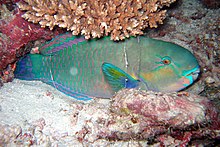Chlorurus sordidus, known commonly as the daisy parrotfish or bullethead parrotfish, is a species of marine fish in the family Scaridae.
| Chlorurus sordidus | |
|---|---|

| |
| Scientific classification | |
| Domain: | Eukaryota |
| Kingdom: | Animalia |
| Phylum: | Chordata |
| Class: | Actinopterygii |
| Order: | Labriformes |
| Family: | Scaridae |
| Genus: | Chlorurus |
| Species: | C. sordidus
|
| Binomial name | |
| Chlorurus sordidus (Forsskål, 1775)
| |
| Synonyms[2] | |
| |
Description
editThe initial phase has very variable colouration. The smaller fishes can be a uniform dark brown to light gray and they may or may not possess a light band surrounding a dark spot on the caudal peduncle. Larger specimens can show a series of irregular rows of small, light spots towards the tail or they may have the light band surrounding the dark spot on the caudal peduncle. The terminal phase, male, is also variable and may have a large tan area on the flanks or on its caudal peduncle. It has a rounded snout.[2]
Chlorurus sordidus is a medium size fish and can reach a maximum size of 40 cm (16 in) length.[2]
Distribution
editChlorurus sordidus is widespread throughout the tropical waters of the Indo-Pacific region, Red Sea included.[3]
Habitat and biology
editBefore going to sleep, Chlorurus sordidus secretes a mucus which surrounds the fish in a complete cocoon. The purpose of this mucus cocoon is not completely understood, but one theory is that it protects the fish from parasitic gnathiids.[4] This species is known to be predated on by the honeycomb grouper (Epinephelus merra) and the coral trout (Plectropomus leopardus), its parasites include the monogenean Benedenia scari.[3] It is a sociable fish which schools with other parrotfishes such as Scarus psittacus.[5]
Chlorurus sordidus is one of the most widespread species of parrotfish, and it is highly variable with some of the geographically determined forms probably being at least subspecies. It occurs in both coral rich and open pavement areas of shallow reef flats, in lagoon reefs and seaward reefs, it can also be found at drop-offs. The juveniles inhabit areas of coral rubble in reef flats and lagoons. The juveniles and females in their initial phase form large groups that move long distances between their feeding grounds and the areas used for sleeping at night. They feed on benthic algae. This species is a protogynous hermaphrodite and the sex change occurs when the attain a total length of 35.1–47.2 centimetres (13.8–18.6 in).[2]
Taxonomy
editChlorurus sordidus has been split by some authorities and the Red Sea dn Indian Ocean populations are regarded as C. sordidus while Chlorurus spilurus occurs in the Pacific and Eastern Indian Ocean, this is based on mitochondrial DNA sequencing and on morphological data. It is also probable that the Red Sea population will also be demonstrated to be specifically distinct.[1] Scarus sordidus was described by the Swedish explorer, orientalist and naturalist Peter Forsskål (1732-1763), the description was published in 1775 with the type locality being Hurghada in Egypt.[6]
References
edit- ^ a b Choat, J.H.; Carpenter, K.E.; Clements, K.D.; Rocha, L.A.; Russell, B.; Myers, R.; Lazuardi, M.E.; Muljadi, A.; Pardede, S.; Rahardjo, P. (2012). "Chlorurus sordidus". IUCN Red List of Threatened Species. 2012: e.T190715A17795228. doi:10.2305/IUCN.UK.2012.RLTS.T190715A17795228.en. Retrieved 20 November 2021.
- ^ a b c d Froese, Rainer; Pauly, Daniel (eds.). "Chlorurus sordidus". FishBase. August 2019 version.
- ^ a b "Bullethead Parrotfish Chlorurus sordidus (Forsskål 1775)". eol.com. Retrieved 9 February 2020.
- ^ Yong, Ed (2010-11-17). "Parrotfish sleep in a mosquito net made of mucus". Discover. Retrieved 2019-08-31.
- ^ Steven S. Amesbury & Robert F. Myers (2001). "Chlorurus sordidus Forsskål (Multicolored Parrotfish; Palagsi, Lagua)". Guide to the Coastal Resources of Guam: Vol. 1 THE FISHES. University of Guam. Archived from the original on 2012-10-24.
- ^ Eschmeyer, William N.; Fricke, Ron & van der Laan, Richard (eds.). "Scarus sordidus". Catalog of Fishes. California Academy of Sciences. Retrieved 9 February 2020.
External links
edit- Media related to Chlorurus sordidus at Wikimedia Commons
- http://www.marinespecies.org/aphia.php?p=taxdetails&id=219082
- https://www.zesea.com/en/parrot-fish-working-for-coral-reefs/
- Photos of Chlorurus sordidus on Sealife Collection
